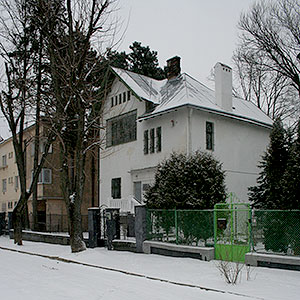- КАРПАТИ.INFO
- Ukraine
- Lviv region
- Lviv and surroundings
- Lviv
- Basivka
- Bibrka
- Bryukhovychi
- Velyky Lyubin
- Vynnyky
- Vyshnya
- Vidnyky
- Vovkiv
- Volya-Vysotska
- Horodok
- Hrimne
- Dubliany
- Zhovkva
- Zashkiv
- Zvenyhorod
- Kamyanka-Buzka
- Kernytsya
- Komarno
- Krekhiv
- Kulykiv
- Lavrykiv
- Pyatnychany
- Lviv suburbs
- Peremyshlyany
- Potelych
- Pustomyty
- Rava-Ruska
- Rakovets
- Svirzh
- Stara Skvaryava
- Stare Selo
- Tovshchiv
- Univ
- Shchyrets
- Lviv
- Museums, galleries, art exhibitions
- I. G. Pinzel Sculpture Museum
Lviv region
Lviv and surroundings
- Lviv
- Basivka
- Bibrka
- Bryukhovychi
- Velyky Lyubin
- Vynnyky
- Vyshnya
- Vidnyky
- Vovkiv
- Volya-Vysotska
- Horodok
- Hrimne
- Dubliany
- Zhovkva
- Zashkiv
- Zvenyhorod
- Kamyanka-Buzka
- Kernytsya
- Komarno
- Krekhiv
- Kulykiv
- Lavrykiv
- Pyatnychany
- Lviv suburbs
- Peremyshlyany
- Potelych
- Pustomyty
- Rava-Ruska
- Rakovets
- Svirzh
- Stara Skvaryava
- Stare Selo
- Tovshchiv
- Univ
- Shchyrets
Lviv
Museums, galleries, art exhibitions
I. G. Pinzel Sculpture Museum
I. G. PINZEL Sculpture Museum
Lviv National Arts Gallery Department
Description:
The museum is located in the architectural monument of the XVII century (former Clares Church). The Church of the Immaculate Conception of the Virgin Mary building was finished in 1607 year and it was aspersed at the same time with St. Voytykh Church in Lviv. In 1749 Martselina Dubrovska hegumeness broadened the monastery, having built its fourth part out of foundation. Church and monastery existed till 1782, that year the monastery was abolished and transformed into tobacco storehouse, and in its rooms customs services were located. The church was as a storehouse till 1898, when it was handed to the high school. In 1899-1900 reconditioning works were held there. One more restoration was held in 1937-1939 to adapt the building to garrison church. The project of the building restoration and of the new tower building was done by Anton Lobos architect.
In the church Stanislav Stroyinsky's frescos are kept, they are done in 1760-es years with the theme of the Books of the Old and New Covenant, and the scenes from the saints of the bernardine-clares nuns order life. While the church was used as a storehouse, the fresco of the southern wall was destroyed. On that place in 1898-1899 three compositions with Polish history of T. Popel artist's work appeared: Sobieski's Entry to Vienna, John Casimir's Oath in Lviv Cathedral Church and Lviv Bernardine Monastery Defence. Lviv collection of baroque sculpture was collected in Lviv Art Gallery as a result of the museum's staff expeditionary work in 1960-1970 years. At that time when this Ukrainian heritage of culture was doomed to a complete destruction, a small group of workers saved near two thousand of art works. I. G. Pinzel Museum of baroque sculpture was set up on a basis of a famous master's materials which were lucky to be saved.
Johann Georg Pinzel is one of the most talented sculptors of the ХVIII century in Europe, his creative work gained its biggest scope and power in the second half of the XVIII century. He managed to reach the perfection in mysticism and dramatic effect portraying, it is obvious in those works which are exposed in the museum, among them — the Angel, the Crucifix, Abraham's Immolation, Samson killing the Lion and other worldwide known works.
In the church Stanislav Stroyinsky's frescos are kept, they are done in 1760-es years with the theme of the Books of the Old and New Covenant, and the scenes from the saints of the bernardine-clares nuns order life. While the church was used as a storehouse, the fresco of the southern wall was destroyed. On that place in 1898-1899 three compositions with Polish history of T. Popel artist's work appeared: Sobieski's Entry to Vienna, John Casimir's Oath in Lviv Cathedral Church and Lviv Bernardine Monastery Defence. Lviv collection of baroque sculpture was collected in Lviv Art Gallery as a result of the museum's staff expeditionary work in 1960-1970 years. At that time when this Ukrainian heritage of culture was doomed to a complete destruction, a small group of workers saved near two thousand of art works. I. G. Pinzel Museum of baroque sculpture was set up on a basis of a famous master's materials which were lucky to be saved.
Johann Georg Pinzel is one of the most talented sculptors of the ХVIII century in Europe, his creative work gained its biggest scope and power in the second half of the XVIII century. He managed to reach the perfection in mysticism and dramatic effect portraying, it is obvious in those works which are exposed in the museum, among them — the Angel, the Crucifix, Abraham's Immolation, Samson killing the Lion and other worldwide known works.
Working hours:
In summer period: 11:00-18:00 (ticket office 16:00).
In winter period: 10:00-17:00 (ticket office till 16:00).
On Sunday: 12:00-17:00 (ticket office till 16:00).
Closed on Mondays.
In winter period: 10:00-17:00 (ticket office till 16:00).
On Sunday: 12:00-17:00 (ticket office till 16:00).
Closed on Mondays.
Entrance fee:
Adults — 50 UAH.
Student — 30 UAH.
Children — 20 UAH.
Student — 30 UAH.
Children — 20 UAH.
Excursion rates:
100 UAH per groups.
Contacts:
How to get there:
Go to the museum by tram #2 to Mytna square tram stop (beginning of Lychakivska street).
GPS:
© 2005-2025 karpaty.info
All rights reserved. No part of this site may be reproduced without our written permission.

 Ukraine
Ukraine Poland
Poland Slovakia
Slovakia
 Українською
Українською






























































































































